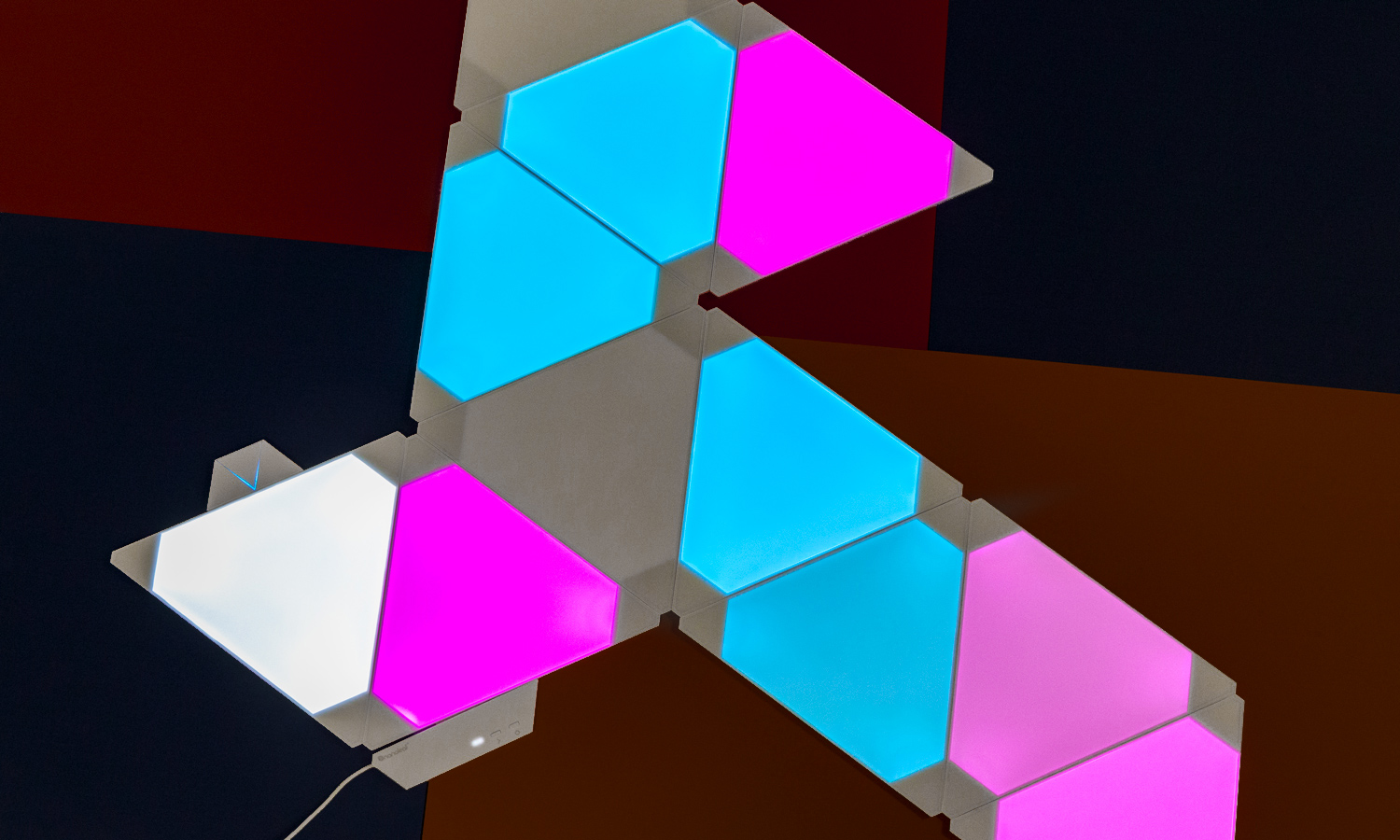Tom's Guide Verdict
You can program these triangular LEDs to light up in millions of color combinations — and even respond to music.
Pros
- +
Creates a fun light show
- +
Customizable light patterns
- +
Easy to set up
- +
Reacts to sounds with adapter
- +
Works with Alexa, Google Assistant and Siri
Cons
- -
Need to use adhesive to mount to wall
- -
Loose connectors between panels
Why you can trust Tom's Guide
I've never had as much fun with smart lights as I did with the Nanoleaf Auroras. They might be expensive and impractical, but they can instantly transform any space into a next-generation disco. While these lights aren't meant to replace traditional smart bulbs like the Philips Hue, they will instantly create a fun, color-filled environment wherever you place them.
Design
The Nanoleaf Aurora starter kit (which the company calls the Smarter Kit) comes with nine triangular panels, the controller (which also provides power to the panels) and nine connectors, which is how you link the panels to each other. Each side of the panel has a slot for a connector, so there's virtually no limit to how you can arrange them. Each controller can power up to 30 panels.

Each panel, which measures about 9 inches along each side, and is about a quarter of an inch thick, is capable of producing 6.7 million colors, as well as tunable white light ranging from 1,200 to 6,500 Kelvin. The corners of each panel don't light up, though, which compromises the overall look — but not by much.
It was a cinch to link all the panels together, but I wish the connection had been a bit more secure; any little movement, and the panels would slide apart from one another. However, the kit also comes with some double-sided foam tape, so you can mount the panels to a wall; they're definitely too delicate to stand on.
MORE: Best Smart Home Gadgets 2018
The kit sells for $199; an expansion pack, which includes three panels and connectors, costs $69.
I also highly recommend buying the Nanoleaf Aurora Rhythm Sound / Music Add-on Module ($49); plug this into the panels, and they'll change color based on the music playing. More on that in a moment.
Get instant access to breaking news, the hottest reviews, great deals and helpful tips.
Performance
After turning on the Nanoleaf Aurora (along with the sound module), I felt like I was John Travolta in Saturday Night Fever. Just for kicks, I turned on the Bee Gees' Stayin' Alive, and the lights put on a show like the disco floor from the music. It was really groovy to watch the lights dance to the beats. All I needed was a pair of bell bottoms, and I would have been set.

What's cool is that, with the Rhythm module, the lights will react to any noise, and the color will change depending on the tone; I would clap my hands, and there'd be a brief explosion of red light, while stomping my foot on the floor produced a bevy of blues.
If you're looking for a more mellow experience, the lights have you covered there, too. Through the Nanoleaf app, you can select from preset color schemes (such as Color Burst, Forest and Romantic). The Color Burst scene, for instance, will slowly illuminate all the panels in one color, then gradually cycle them through other colors. A separate Rhythm section is designed for those using the sound module.
Through the Nanoleaf app, you can select from preset color schemes (such as Color Burst, Forest and Romantic).
You can also create your own lighting scenes; just as with arranging the panels, you're only limited by your imagination. The app almost gives you too many choices. In addition to selecting the colors, you can pick the order in which they appear, how fast they show up and the brightness of each. You can even create custom scenes to work with the Rhythm module.
Smart home features
These are some thoroughly connected lights: You can control them using Alexa, Google Assistant, Siri and IFTTT. That's more than you can say for most smart lights, with the exception of Philips Hue.
Bottom Line
You're not going to use the Nanoleaf Auroras the same way you'd use Philips Hue bulbs; the Aurora lights are intended more for fun than for practicality. So, if you have $199 to spend — plus an extra $49 for the Rhythm module — then you'll find the Auroras to be a great party trick and a novel way to create the ultimate in ambiance.
Credit: Tom's Guide

Michael A. Prospero is the U.S. Editor-in-Chief for Tom’s Guide. He oversees all evergreen content and oversees the Homes, Smart Home, and Fitness/Wearables categories for the site. In his spare time, he also tests out the latest drones, electric scooters, and smart home gadgets, such as video doorbells. Before his tenure at Tom's Guide, he was the Reviews Editor for Laptop Magazine, a reporter at Fast Company, the Times of Trenton, and, many eons back, an intern at George magazine. He received his undergraduate degree from Boston College, where he worked on the campus newspaper The Heights, and then attended the Columbia University school of Journalism. When he’s not testing out the latest running watch, electric scooter, or skiing or training for a marathon, he’s probably using the latest sous vide machine, smoker, or pizza oven, to the delight — or chagrin — of his family.
